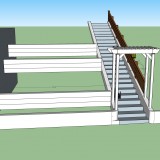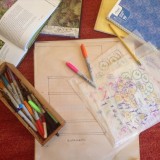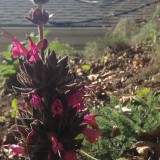I’ve been avoiding writing about the front yard project’s developments because, frankly, I’m not sure what is going on out there. It’s a little crazy.
The first flush of spring color, the wildflowers and other annuals which bloom with the winter rains, is almost gone now, while the summer bloomers haven’t kicked in. This is what I see if I go out and peer at my slope–a tangle of plants, some of which are doing better than others. What everyone else sees are the sunflowers.
The reign of the wild sunflowers
We have sunflowers. Lots of them. They’re wild sunflowers–not the kind that produce the big seeds, but the kind that grow along the freeway. I suspect these come from that big sunflower that I let grow up at the top of the hill last year which was, most likely, a hybridized descendant of an ornamental sunflower, “Lemon Queen” that Erik planted for the Great Sunflower Project several years ago. I pulled many, many seedlings but decided to let a few grow (four, I think?) on the slope, just to see what would happen.
Ha!
First, I believe in the power of volunteers. They want to be exactly where they’ve sprouted, so they tend to do very well. Why pull a happy volunteer and hope the transplant you’re trying to coerce to live in that spot will do just as well? Most likely it won’t.
Also, sunflowers are very popular with the birds and the bees, and this yard is supposed to be about feeding those guys. And finally, I had this notion that they might provide some shade from the harsh sun for young plants. That they do, but of course they’re also causing chaos.
This is a perpetual problem for me, balancing the exuberance of annual volunteers, such as Nasturtiums, California poppies and sunflowers with the needs of the the less showy perennial plants. I love the seasonal color brought by the spring annuals, but I also have to patrol to make sure they’re not smothering any of my perennials. Inevitably, I miss a few.
Out on the front slope right now, the perennials are holding on beneath the sunflowers. Some are doing fine, some may be a little stunted. The risk I’m running is that the whole center of the slope will look terrible when the sunflowers go. For this reason, I should take them out now. This is what I think every day, but I just can’t do it. I like them, and as I said, they’re feeding lots of creatures.
These sunflowers are not native sunflowers. The native sunflower is shorter and better behaved. I might try to swap those out for these guys next year, though these guys may be hard to dissuade.

Some of the wildflowers earlier this spring: The pink are clarkia, the white is yarrow, the orange are Nasturtium (not wildflowers), the purple are Phacelia tanacetifolia.
Other wildflowers
I threw down a good deal of native California wildflower seed last fall, hoping to fill my barren slope come spring with lots of amazing wildflower action. That did not pan out.
I figure birds might have nabbed the seed, although wildflowers are fussy things, so maybe just decided they didn’t like the conditions. In terms of the birds, I did mix about half of the seeds with clay before seeding to protect them from the birds. Maybe the clay coated seeds were the only ones that sprouted? Or maybe that didn’t work at all? Who can tell?
Surprises
I knew this planting would be full of surprises, because I’m unfamiliar with many of the plants I used. So I’m figuring out how they grow and what they like and how they get along. It’s all an ongoing experiment.
Surprise number one is Golden Yarrow (Eriophyllum confertiflorum) which is not a true yarrow at all. This was supposed to be a relatively small plant, maybe one foot high by two feet wide. I planted 3, and they’ve taken over the left side of the slope. Obviously, they like sunny hillsides! But you know, that side of the slope gets some shade, too, and the shade patches aren’t putting them off, either. Nor are the sunflowers. Really, between the Golden Yarrow and the sunflowers its a miracle that anything else has room to grow.
I give the Eriophyllum confertiflorum a big thumbs up for being an attractive, fast-growing plant. It’s also supposed to be good for butterflies, though I haven’t noticed any butterfly interest in the blooms yet. It’s been blooming since early spring, and it’s categorized as a spring/summer bloomer, so it will be interesting to see how long the bloom lasts.
I like this plant, but I didn’t really intend to cover the entire hillside with it, so I may need to take some action to make it play nice with others. Or, I could just let it take over the whole slope, pour myself a cocktail and call it quits on the landscaping. It wouldn’t be the worse solution in the world.
Surprise #2 is how hard it is to get grass to grow. Native grasses remain a mystery to me. I lost many of the grasses I planted this winter and others are growing slowly. I bought new grass to replace the lost ones, and it’s doing okay, but is a little lost in the crowd on the slope. I’m hoping that it will start reseeding itself, because I don’t want to buy any more of it. I’m figuring that getting a meadow situation started will take time –and the cooperation of the grass. If it likes the slope, I’ll get a grassy meadow in coming years, but not this year. If grass is not to be, I’ll have to punt.
And yes, it may have been more sensible (certainly more affordable) to scatter native grass seed instead of buying plants, but considering how well my wildflower seed did, I suspect it would have all gone into bird bellies as well.

A pleasant surprise: blue-eyed grass. What a pretty plant it is! Unfortunately it is summer deciduous, so it’s on its way out. On the upside, it reseeds itself.
Rampant sentimentality getting in the way of design principles
The sunflowers are the most obvious example, but I also have a patch of Mexican sage left over from the old days which I didn’t take out because the hummingbirds love it, and it feeds them during periods when bloom is low everywhere else, and because it is completely naturalized on the slope. It’s so happy and carefree, it seem a shame to take it out. I’m not sure if I could get rid of it, even if I tried! As it is, I keep digging it up as it tries to pop up everywhere, only allowing one stand to grow. But that stand is oppressing some of my other plantings.
I suspect Piet Oudolf does not think like this. This is why he is Piet Oudolf and I’m the Crazy Sunflower Lady.
On similar lines, I have a native sage on the slope as well, also leftover from the old days. It’s a great plant, but it wants to be large, and doesn’t really match my small scale meadow scheme, so I keep it, but I keep it trimmed back. Generally I don’t like “make work” schemes like that. Stuff should just be the right size for the space. Trimming is just a waste of energy for you and the plant. But I’ll leave it for now, and if I decide to give the slope over to the golden yarrow, I’ll let the Mexican sage and the purple sage go, too, and see who comes out on top. It would be like botanical cage fighting.
Speaking of cage fighting, at the very top of the slope we have a cardoon plant. You can see it in the top left of the top picture. Cardoons are technically invasive plants and one of the bêtes noires of the native plant folks. I doubt we’ll ever be on a native plant garden tour with this monster crowning our so-called native landscape, but Erik loves, loves, loves this plant for inexplicable reasons, so I can’t take it out.
The cardoon’s huge leaves are perpetually reaching out to overshade my natives, so I keep hacking them back (more make-work activity). However, I learned to like the cardoon much more this spring when I discovered it had become a ladybug nursery. I’ve never seen so many pupating lady bugs in one place. It was amazing. It probably housed more than 100 developing ladybugs at one point. And birds like that plant, too. They’re eating something off it–not the ladybugs, I think. So I guess it’s earning its keep.
The mystery of the front terrace
The first, front or bottom-most terrace on the slope turns out to have remarkably bad soil. The whole slope has variable soil, due to construction digging, but the front terrace is really distinct: distinctly crappy, that is. Its main problem is that it’s hydrophobic, and no other part of the slope is like that. Hydrophobic means that water doesn’t really sink into the soil very easily, and even after it seems to sink in, it sort of vanishes into the void, as if I never watered. It really is like a magic trick.
The plants down there are alive, but much smaller than their peers above. And no wonder–they’re underwatered.
The cure for bad soil is, as always, compost and mulch and worm poo. I need to add a lot of that stuff to this poor terrace, but I have a problem. The soil is already up to the top of the retaining wall–if I add more, it will spill all over the sidewalk. So I have a choice. I can add edging to give me a few more inches of depth for amendments, or I can dig up that terrace, pulling up the plants in the process, and hope they don’t mind being transplanted. Or I could leave it be, do small interventions like teas and hope the plants make it.
Plans
These days I’m pretty much battening down the hatches for the long dry summer. Erik and I have installed a “smart” irrigation system to make watering easier (we’ll blog about that after testing it). I’m going to do a heavy mulching soon as the wildflowers and other spring annuals finish up. At that time I might have to make some decisions about the sunflowers.
It will be interesting to see what the slope looks like without the sunflowers hogging all the attention. There are also summer and fall bloomers hidden in there, who will hopefully come to the foreground later this year.
Overall, I’m happy enough to wait and see how this system stabilizes over time. It’s not perfect, but it’s not bad. It’s a little crazy, but it’s feeding critters, which is what it’s supposed to do, so I’m not complaining. I have the feeling it will look much different next year. We’ll find out!
I’ll do a late summer/fall update to see how this thing looks in the dog days of the year.










Posts like these are why I really love your blog and podcast. I love seeing the real world challenges.
You have to admit that the sunflowers are quite cheerful! I love the play between everything that you have going on, especially the nasturtiums and the yarrow.
After reading PWW, I looked around my yard last year and just sighed looking at all of the things that I now understood really didn’t make sense. So, a huge amount of stuff got moved this spring and a lot of things “feel” better. I’m trying to combine the ideas behind fruit tree guilds with the ideas in PWW, but it’s going to take another year or two to figure out whether it can be a) aesthetically pleasing b) actually help the trees, and c) somewhat sustainable. The plantings that have had two years to fill in look blended while everything else still looks blotchy. And I’m realizing that while the plants are doing well and I’ve started to figure out how to put different shapes of plants next to each other…my understand of establishing a cohesive color palette is wanting.
But, the native bees are very happy, the ladybugs are here, and there is more general wildlife activity in my yard than the three previous years, so something must be working!
Thanks, Kyle. It is a process, isn’t it? But I always take comfort in the happy critters. I figure if we’ve got that going, the rest is gravy.
What a timely post – I just rescued some tomatoes from under the 5′ tall bolting swiss chard that just toppled over. And I hear you on the cardoon. They are pretty cool. I planted Jeruselam artichokes a while back in a barren, dry area of my yard, and they came up with similarly straggly sunflower bushes. Works pretty well, and breaks up our clay soil too. Occasionally I’ll eat them, but usually I just let them do their thing.
I’ve never had any luck with seed bombs and the whole clay thing. I can see how that might work in a wet area thta gets rain all the time, but here in dry Ca, I think the clay just coats the seed and turns into a mummy.
As for amending the soil, why not dig a hole here and there and insert kitchen waste? Like little pits of rotting compost. Then you don’t have to move any plants, you’re disturbing minimal amts of soil. Just have to worry about digging raccoons or dogs.
Thanks, Rena! Like you, I’ve got some thoughts on seed bombs in dry climates, which may take the form of a controversial post.
In this case these seeds were just coated with a small amount of clay and mixed with compost for easier distribution–it was more like a slurry than balls. I made sure I put them out before the rains, such as they were, so I hope the clay melted off, but you know, maybe it didn’t!
And yes, some kind of injection process might help that soil. Worm castings can also go down holes like that.
Oh, I also wanted to add that I bought the Gardening With Less Water book linked here and implemented some clay pots over the last week. I can’t believe the difference. I felt like my soil was still plenty damp from spring rains and plenty of mulch, but the plants by the pots have shot up like crazy this week, while the rest are still puttering along. I didn’t feel at all like I was under watering, but they say otherwise! And the pots really do work.
Cool! I’m glad it’s working so well. (Plants like water, don’t they? 😉 ) We’re trying to find the author to invite him on the podcast.
The sunflower probably is a descendant of the California native returning through the generations to it’s wild state..pretty cool. If you let it seed into the rough bottom terrace soil maybe it would stay a little more, er, polite in habit. I’m always surprised the golden yarrow isn’t more widely planted; so cheerful, easy, and year-round good-lookin’.
These updates are awesome..more pictures please! Love to see a garden grow.
Thank you Elle!
Oh..my! I’ve been waiting for an update on this! Overall it looks great, but ABSOLUTELY yank those sunflowers…all they’re going to do is smother all the hard work you’ve put in, especially after they go to seed and produce hundreds of new plants (unless you decide to just go the sunflower monoculture route). It takes years to completely and properly restore a native landscape – after 5 years restoring ours, my eyes have been opened as to how much painstaking effort goes into making a garden look “natural”. One note on your failed seeds: its worth keeping in mind that many natives have seed that will stay dormant (often for years) until the conditions are favorable for them to grow – it’s quite possible that you have an active seed bank that just needs more time to germinate (I imagine CA natives are even more adapted to this as they wait out drought conditions?). Regarding your grasses, don’t give up! The main things i’ve learned is that they 1) do not like to be crowded/shaded, 2) need lots of sun, 3) are slow to establish as they build extensive roots underground, and finally 4) are late to emerge from dormancy (at least here in Minnesota). I’ve found it’s been best to buy seed and start the grasses in flats…it’s extremely economical and they germinate really quickly! I just wanted to encourage you to keep with it; your meadow is still just a baby…I say if you’re up for coddling it a few more seasons it will really pay off! Give it time and keep those thugs under control. Thanks and good luck!
Thanks, Andy. I hear what you’re saying about the sunflowers. And thanks for all the other advice, as well! Grasses in flats will be the next step if these guys don’t take well.
Okay, I think it looks fantastic! A little wild, yes, but beautiful. I would stop and admire this if I was walking by. Perhaps I wish I could be crazy sunflower lady?! (I love sunflowers, but for whatever reason haven’t had them work out in my space.) I love the wild meadowy look and I bet the bees, bugs, and birds LOVE the space.
Thank you! You know, I’ve never been able to plant sunflowers and have them work out. They have to volunteer. They remind me of cats.
p.s. I wouldn’t bother swapping the sunflowers out; as mentioned above our native Delta Sunflower, Helianthus annuus, is precursor to the domesticated sunflowers and given a good amount of water (thanks be for the rains!) the size you have is totally normal even for the wild species.
Wow the challenges of gardening in your area are so interesting! I have always lived in the midwest, and my current location presents its own challenges, mainly awful clay soil. I am all about natives these days, to help the native fauna and for the additional reason that they are easier to grow. And I am part of the grass roots effort to help rescue the monarch butterfly, so I am planting milkweed and more natives that are nectar producers.
As far as the sunflowers – I thought most Helianthus WERE native to North America? I see them on our roadsides too (and in my garden). What I find interesting is the difference in the appearance as I drive to different areas – an hour north of my area I see plants with smaller, but more, flowers. I see the same when I cross the Mississippi and enter Missouri. Helianthus there is a ‘pest’ in crop fields, which is not the case here.
Love your gardening updates! good luck with your dry summer gardening.
You could lift out the perennials when they are dormant and work in a bit more organic matter, worm casting and then tuck them back in and lightly mulch them in with something close to what these plants would find in their more natural setting.
Good idea to wait until they’re dormant. This will be a good project for our endless autumn–if I can keep them alive until then! I’ve put drip on them, which should help with the water absorption.
I foolishly allowed a few – maybe 5 – sunflowers to grow in my side yard. The orioles loved them and I loved watching the orioles. Later in the fall, I removed all the remaining seed heads. For the last 4 years I have been yanking out sunflowers. This year we have had tons of rain, tons of sunflowers have come up, and I’m still yanking tons of them out!
I know! I pulled up so many this year, and still I’m letting the things grow. I’m trying to find the will to pull them.
have you tested the bottom terrace’s soil? I wonder if there’s a lot of sand under a layer of topsoil. We had an area with a couple inches of topsoil but then FEET of sand below that. It wouldn’t hold water, so I added mulch, which helped one year. But the plants just wouldn’t grow! I decided to move them, and then discovered the sand. Sand explained the stunted growth (deep roots were useless) too.
That’s crazy! I don’t think we have sand (sand is rare here in clay country) but I’ll check. 😉
I think your yard looks natural and lush. Maybe I would go for a more colorful setting, but I may end up getting something not very balanced. By the way, what is the species of sunflower that grows in your yard ? Is that https://en.wikipedia.org/wiki/Helianthus_annuus ? Beautiful flower, no wonder certain European artist was such a fan of them. Your herbal volunteer power project sounds very reasonable, it reminds of a certain line of thought in tech: http://www.catb.org/esr/writings/cathedral-bazaar/cathedral-bazaar/ It describes different relationship with planning vs. letting things evolve. A garden, as an ecosystem, favors the bazaar approach.
Golden Yarrow is an eye-pleaser, in my opinion. Have you given any thought to growing true yarrow – https://herbalref.com/achillea-yarrow-millefolii-herba/ – as a source of herbal remedies ?
I am sorry, haven’t followed your blog for very long.
Thank you so much for your thoughts!
I’m a little confused about sunflowers in general–I believe it is h. annuus, though there is an agricultural variety of h. annuus which makes edible seeds, and this is not that–it is black centered and produces tiny seeds. For instance, is not pictured on the wiki page you linked to. I’d simply call it a wild sunflower, but I do find wild sunflowers called h. annuus as well–this article seems to describe it :http://homeguides.sfgate.com/wild-sunflowers-27069.html
And I love true yarrow, and there is a good deal of it planted on the slope. I hope it will push forward more next year.